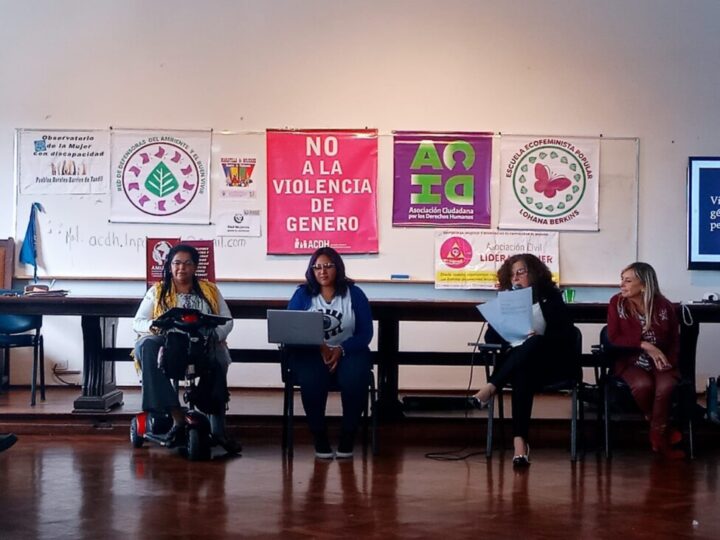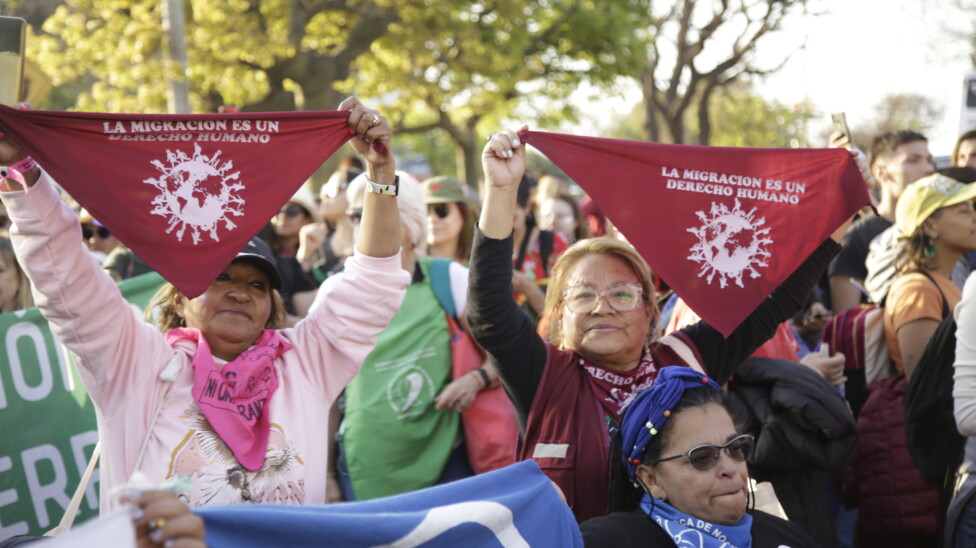BUENOS AIRES, Jul 27 (IPS) – Remi Cáceres experienced gender-based violence firsthand. She struggled, got out and today helps other women in Argentina to find an escape valve. But because she is in a wheelchair and is a foreign national, she says the process was even more painful and arduous: “Being a migrant with a disability, it’s two or three times harder. You have to empower yourself and it’s very difficult.”
When she came to Buenos Aires from Paraguay, she was already married and had had her legs amputated due to a spinal tumor. She suffered violence for several years until she was able to report her aggressor, got the police to remove him from her home and raised her two daughters watching after parked cars for spare change in a suburb of the capital
On the streets she met militant members of the Central de Trabajadores Argentinos (CTA), one of the central unions in this South American country, who encouraged her to join forces with other workers, to create cooperatives and to strengthen herself in labor and political terms. Since then she has come a long way and today she is the CTA’s Secretary for Disability.
“The places where women victims of gender-based violence are given assistance are not accessible to people who are in wheelchairs or are bedridden. And the shelters don’t know what to do with disabled women. Recently, a woman told me that she was sent back home with her aggressor,” Remi told IPS.
From her position in the CTA, Remi is one of the leaders of a project aimed at seeking information and empowering migrant, transgender and disabled women victims of gender violence living in different parts of Argentina, for which 300 women were interviewed, 100 from each of these groups.
The data obtained are shocking, since eight out of 10 women stated that they had experienced or are currently experiencing situations of violence or discrimination and, in the case of the transgender population, the rate reached 98 percent.
Most of the situations, they said, occurred in public spaces. Almost 85 percent said they had experienced hostility in streets, squares, public transportation and shops or other commercial facilities. And more than a quarter (26 percent) mentioned hospitals or health centers as places where violence and discrimination were common.

Another interesting finding was that men are generally the aggressors in the home or other private settings, but in public settings and institutions, women are the aggressors in similar or even higher proportions.
The study was carried out by the Citizen Association for Human Rights (ACDH), an NGO that has been working to prevent violence in Argentina since 2002, with the participation of different organizations that represent disabled, trans and migrant women’s groups in this Southern Cone country.
It forms part of a larger initiative, dubbed Wonder Women Against Violence, which has received financial support for the period 2022-2025 from the UN Trust Fund to End Violence against Women. Since 1996, this fund has supported projects in 140 countries for a total of 215 million dollars.
The initiative includes trainings aimed at providing tools for access to justice to the most vulnerable groups, which began to be offered in 2022 by different organizations to more than 1,000 women so far.
Courses have also been held for officials and staff of national, provincial and municipal governments and the judiciary, with the aim of raising awareness on how to deal with cases of gender violence.
Fewer complaints
“Argentina has made great progress in recent years in terms of laws and public policies on violence against women, but despite this, one woman dies every day from femicide (gender-based murders),” ADCH president María José Lubertino told IPS.
“In this case, we decided to work with forgotten women. We were struck by the fact that there were very few migrant, trans and disabled women in the public registers of gender-violence complaints. We discovered that they do not suffer less violence, but that they report it less,” she added.
Lubertino, a lawyer who has chaired the governmental National Institute against Discrimination, Xenophobia and Racism (INADI), argues that these are systematically oppressed and discriminated groups that, in her experience, face their own fears when it comes to reporting cases: “migrants are afraid of reprisals, trans women assume that no one will believe them and disabled women often want to protect their privacy.”
Indeed, the research showed that 70 percent of trans, migrant and disabled women who suffered violence or discrimination did not file a complaint.
Many spoke of wanting to avoid the feeling of “wasting their time,” as they felt that the complaint would not have any consequences.
Each group faces its own particular hurdles. Migrant women experience discrimination especially in hospitals. Transgender people, in addition to suffering the most aggression (sometimes by the police), suffer specifically from the fact that their chosen identity and name are not recognized. Disabled women say they are excluded from the labor market.
More than three million foreigners live in this country of 46 million people, according to last November’s data from the National Population Directorate. Almost 90 percent of them are from other South American countries, and more than half come from Paraguay and Bolivia. Peru is the third most common country of origin, accounting for about 10 percent.
Of the total number of immigrants, 1,568,350 are female and 1,465,430 are male.
As for people with disabilities, the official registry included more than 1.5 million people by 2022, although it is estimated that there are many more.
Since 2012, a Gender Identity Law recognizes the legal right to change gender identity in Argentina and by April 2022, 12,665 identification documents had been issued based on the individual’s self-perceived identity. Of these, 62 percent identified as female, 35 percent as male and three percent as non-binary.
Different forms of violence
Yuli Almirón has no mobility in her left leg as a result of polio. She is president of the Argentine Polio-Post Polio Association (APPA), which brings together some 800 polio survivors. Yuli is one of the leaders of the trainings.
“Through the trainings, those of us who participated found out about many things,” she told IPS. “We heard, for example, about many cases related to situations of power imbalances. Women with disabilities sometimes suffer violence at the hands of their caregivers.”
The most surprising aspect, however, has to do with the restrictions on access to public policies to help victims of gender-based violence.
The Ministry of Women, Gender and Diversity runs the Acompañar Program, which aims to strengthen the economic independence of women and LGBTI+ women in situations of gender-based violence.
The women are provided the equivalent of one monthly minimum wage for six months, but anyone who receives a disability allowance is excluded.
“We didn’t know those were the rules. It’s a terrible injustice, because disabled victims of violence are the ones who most need to cut economic dependency in order to get out,” said Almirón.
Another of the project’s partner organizations is the Human Rights Civil Association of United Migrant and Refugee Women in Argentina (AMUMRA). Its founder is Natividad Obeso, a Peruvian woman who fled the violence in her country in 1994, during the civil war with the Shining Path guerrilla organization.
“Back then Argentina had no rights-based immigration policy. There was a lot of xenophobia. I was stopped by the police for no reason, when I was going into a supermarket, and they made me clean the whole police station before releasing me,” she said.
Natividad says that public hospitals are one of the main places where migrant women suffer discrimination. “When a migrant woman goes to give birth they always leave her for last,” she said.
“Migrant women suffer all kinds of violence. If they file a complaint, they are stigmatized. That’s why they don’t know how to defend themselves. Even the organizations themselves exclude us. That is why it is essential to support them,” she stressed.
© Inter Press Service (2023) — All Rights ReservedOriginal source: Inter Press Service
Check out our Latest News and Follow us at Facebook
Original Source

